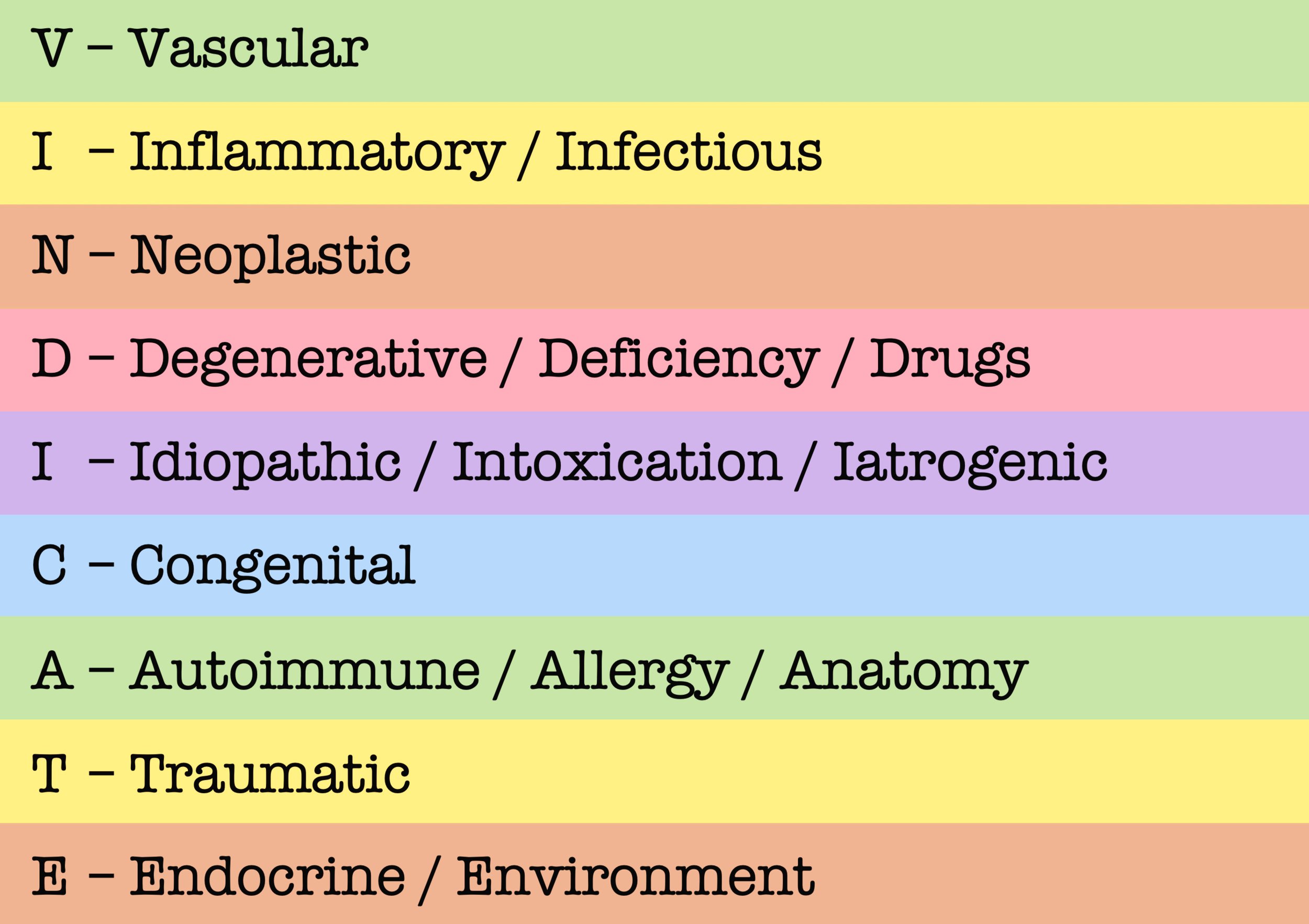Creating Differential Diagnosis List Using VINDICATE.
Introduction
In medicine, patients often present with signs and symptoms that resemble and overlaps with other conditions. Therefore, having the principal diagnosis (or your best suspicion) may not fit the picture perfectly; hence it is essential to think of other conditions that mimic the presentation. The differential diagnosis thus comes into play.
The differential diagnosis list comprises other similar diseases and contains the “not to be missed” conditions, the great imitators and the masqueraders. The “not to be missed” conditions are the red flags; they are the conditions that must be thought out, explored and not ignored. These could be neoplasia and imminent danger such as acute coronary syndrome, subarachnoid haematoma, aortic dissection and so on. The imitators are conditions that love to imitate other conditions. They are generally a challenge to find and are the cause of patients’ and doctors’ frustration. Some examples are rheumatic conditions (SLE, sarcoidosis et cetera), syphilis, amyloidosis, endocrine disorders, et cetera. Finally, the masqueraders act more in the background and are more insidious and subtle. These could be depression, hypothyroidism, central nervous system diseases, malignancies and so on.
A highly experienced doctor will have a differential list in their mind ranked from the most to the least probable cause for each presenting complaint, including the patient’s criteria (age, gender, past medical conditions, et cetera). This list is fine-tuned and malleable and is an invaluable skill to acquire. However, for medical students or newly interns, gathering a focused differential diagnosis list is challenging, which is understandable. Thus having VINDICATE as a mnemonic for the differential diagnosis list is a solid start to build the required skill-set. This mnemonic helps in finding diseases with different aetiology and also considers other groups of diseases. Once a differential list is made, the patient’s thorough and focused history and examination along with adequately chosen investigations will help rule in or out of a particular disease.
Remember, always have in mind these criteria:
Common is common; thus, what is the most likely for this particular patient (include age, gender, presentation, past medical conditions and so on). Think to yourself, if I have to put money down, what would I bet on? What is my top diagnosis? When you hear hooves, would you think horse, zebras or oryx?
Do not miss. These are the red flags and the imminent dangers. What will kill my patient? What must I make sure not to miss when I present the case to my superior?
Imitators are essential to think about when one is still unsure or confused about a specific presentation.
Masqueraders are to be thought out and kept in the back of your mind. Do not think of these first but do keep an eye out for them.
VINDICATE
V – Vascular
These are diseases that can be caused by “vessel” (bleed, inflammed or blocked) or anything related to haematology.
I – Inflammatory / infectious
Any conditions that cause inflammation, such as inflammatory bowel disease. Can be acute or long-standing background inflammation.
N – Neoplastic
Do consider that it can be very subtle at first and puzzling.
D – Degenerative / Deficiency / drugs
Drugs may involve direct effects or withdrawals. Deficiency may occur from other causes such as surgery, inflammation (such as coeliac, Crohn’s disease), autoimmune (pernicious anaemia), diet, access to the right foods, pregnancy (increased demand), helminth and so on.
I – Idiopathic / Intoxication / iatrogenic
A lot of things are idiopathic, unexplainable or unknown, which is very frustrating. Intoxication may involve direct or indirect effects such as withdrawals. Think of poisonings such as alcohol, heavy metals, recreational drugs, prescribed medications, water, salt, cyanide and many other compounds.
C – Congenital
These can be obvious and already diagnosed, such as Marfan, Klinefelter or Down syndrome. Some may not be as obvious such as Ehlers-Danlos or Gilbert syndrome. Some are entirely hidden and can be very lethal such as hypertrophic cardiomyopathy (HCM), where young athletes drop dead at sports events or intracranial berry aneurysms, which increases the chance of rupturing.
A – Autoimmune / Allergic / anatomic
Autoimmune conditions may present much later, be insidious and act as an imitator. Sometimes a lot of investigations need to be made before it is finally diagnosed. With anatomy, a good start would be to think of the most typical abnormal form.
T – Traumatic
It may be self-evident, such as laceration, contusions and concussions and so on, but may also be insidious such as an elderly patient who fell two weeks ago and may have a subdural haematoma.
E – Endocrine / environment
Endocrine has a cocktail of conditions with imitators and masquerader presentations. The environment may include pollution, farm pesticide exposure, or even a clean environment which may cause problems such as the “hygeine theory”. Just imagine where your patient lives and think how it may affect their health.
Other variants
VINDICATES - adding: Something Else/pSychological.
VINDICATEM - adding: Metabolic.
VITAMINS ABCDEK - a different acronym as an anagram.
Published 15th May 2021. Last reviewed 1st December 2021.
Reference
Spinner MA. Mnemonic Monday: VINDICATE – The Universal Mnemonic for Differential Diagnosis. First Aid Team website. https://firstaidteam.com/2013/11/18/vindicate-mnemonic-for-differential-diagnosis/. Updated November 18, 2013. Accessed November 26, 2021.
Zabidi-Hussin ZA. Practical way of creating differential diagnoses through an expanded VITAMINSABCDEK mnemonic. Adv Med Educ Pract. 2016;7:247-248. doi:10.2147/AMEP.S106507



























